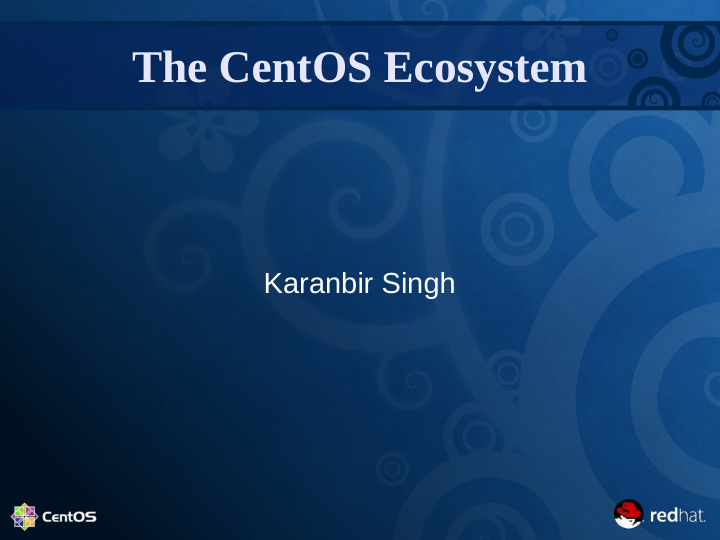



The CentOS Ecosystem Karanbir Singh
The Red Hat relationship
Everything is a SIG Abstract the CentOS Project away from the CentOS Linux distro :: So we can do more and we can be wider inclusive.
The Goals Be a great environment for people to develop, adapt and adopt tools, ● code, projects, apps in and around the Infrastructure demographics. This should include the traditional established roles, as well as create opportunities to evolve into the emerging work roles, eg: containers and cloud. Provide the ecosystem the tools, support and resources they need to ● be successful with the CentOS project. Make our success and relevance be directly linked to the wider ecosystem. Driven by user stories and not vendor / provider ones.
How are we approaching these goals ?
Stream 1 : Availability More reliable mirror network for existing install base ● Extend mirror network to operate over IPv6 ● – Mirrorlist -> done, Self Mirrors -> soon Updated media, evolving to run Monthly ( with a full CI run ) ● More media variants ● Boot.centos.org ● Early access to builds, ( buildlogs.centos.org ) ● ABRT and Debugging in the public space ●
Stream 1 : Availability Alternative Media / Formats ● – Cloud roles ● Aws / gce / rackspace / linode etc ● Hosting vendors / vps instance vendors – Containers ● Docker ( both /_/centos and /u/centos ) ● Base Images & app layered images
Stream 1 : Availability Whatever format, delivery mechanish, runtime environment, bootstrap process – the baseline content is always in sync. Need: Ability to operate outside the constraints of the specific workload.
Stream 2 : Extend Availability Complementing the existing Expanding the existing ● ● expectations : expectations: – ARMv7 – Power8 le/be – Aarch64:ARMv8 – Power7 – i686 – s390x
Regardless of where you want to run your workload, CentOS should provide a good-enough platform within the constraints of that environment.
Lets look at the Layered ecosystem
Stream 3: Facilitate Layers Ability to build on top of the CentOS Linux platform ● ● Towards a component goal ● Directly to satisfy a User Story Dont worry about the user base skew ● Low barrier to entry ● ● Including signup ● Content injection ● Licensing requirements ● Sponsorship requirements
Stream 3: Facilitate Layers Complete Buildsystem for end Git.centos.org : version control ● to end requirements - sync with distro ● - branch from distro or others ● Ability to consume via layers - completely own your branch ● other peoples work in the same environ Cbs.centos.org : koji buildsys ● Ability to contribute into layered - lots of cpu, disk, ram ● repos and scratch builds - local mirrors ● - integrated with git.centos.org ● - automation capabilities ●
Stream 3: Facilitate Layers Testing capabilities via CI.CentOS.org: ● - 768 cores, 3 TiB of ram, 128 SSD based physical machines ● - ability to consume test instances from bare metal, including groups ● - Test iteratively over base + additional layers ● - Lots of reporting options ( Jenkins driven ) ● Content delivery via centos.org ● - build time repos, cbs.centos.org/repos/ ● - testing / eval content via buildlogs.centos.org ● - production content via mirror.centos.org ● - not limited to existing media types, additional formats welcome ●
Early Success stories Base Layer ● Qemu – Libvirt – Libguestfs – Xen – Component Layer ● Gluster FS – Ovirt – App Layer ● OpenStack – Atomic Project –
Early Success stories Developer wins ● Nightly builds for docker / kubernetes allows projects like Mesos to – develop/test against CentOS Linux. Optionally consuming for their own dep chains either: ● In Distro versions ● Upstream Stable versions ● Upstream nightly versions CI / CD pipelines ● Tests to validate docs, regression suites on a dep chain change, and – being able to link like a matrix to build developer and user confidence in a specific stack: eg: GlusterFS doing CI against both itself, the distro, and an evolving set of dep chains ( like libvirt / qemu etc ).
Early Success stories OpenStack : Tested both ways, delivered with confidence. ● RDO and Khaleesi runs nightly. Packages are only pushed on pass. – CentOS Linux snapshots are tested nightly, No package pushes. – The docs and use case validations: – ● On every CentOS Linux rpm update ( dep or not ) ● On every openstack package update ● Run as a stack, rpms both ways only pushed on complete success Result: Using the CentOS Linux Base + CentOS Linux Openstack tested – updates stack, the user should never see content that hasent passed a pre-defined test set.
Early Success stories Atomic App: A complete application in closed loop, containers with real dep ● and in dep tracking. – Single definition – Able to use definable registries to satisfy deps – Dep and in dep tracking of components, so relationships can be identified and acted-on ( eg. Upward escalation of a security issue in an underlying dep container ) – Delivered itself as a CentOS hosted container ( docker for now, but others are easy to add ) – Tested, managed, facilitated within the CentOS CI infra ( Community container pipeline ).
Our focus remains to curate the existing user base, the user mindset and to help create a manageable bridge for those looking to investigate and trial new emerging technologies.
Getting in Touch K Singh ● Twitter.com/kbsingh ● Tel: +44 207 009 4455 ● Email: kbsingh@centos.org ● Kbsingh on irc.freenode.net ●
Recommend
More recommend